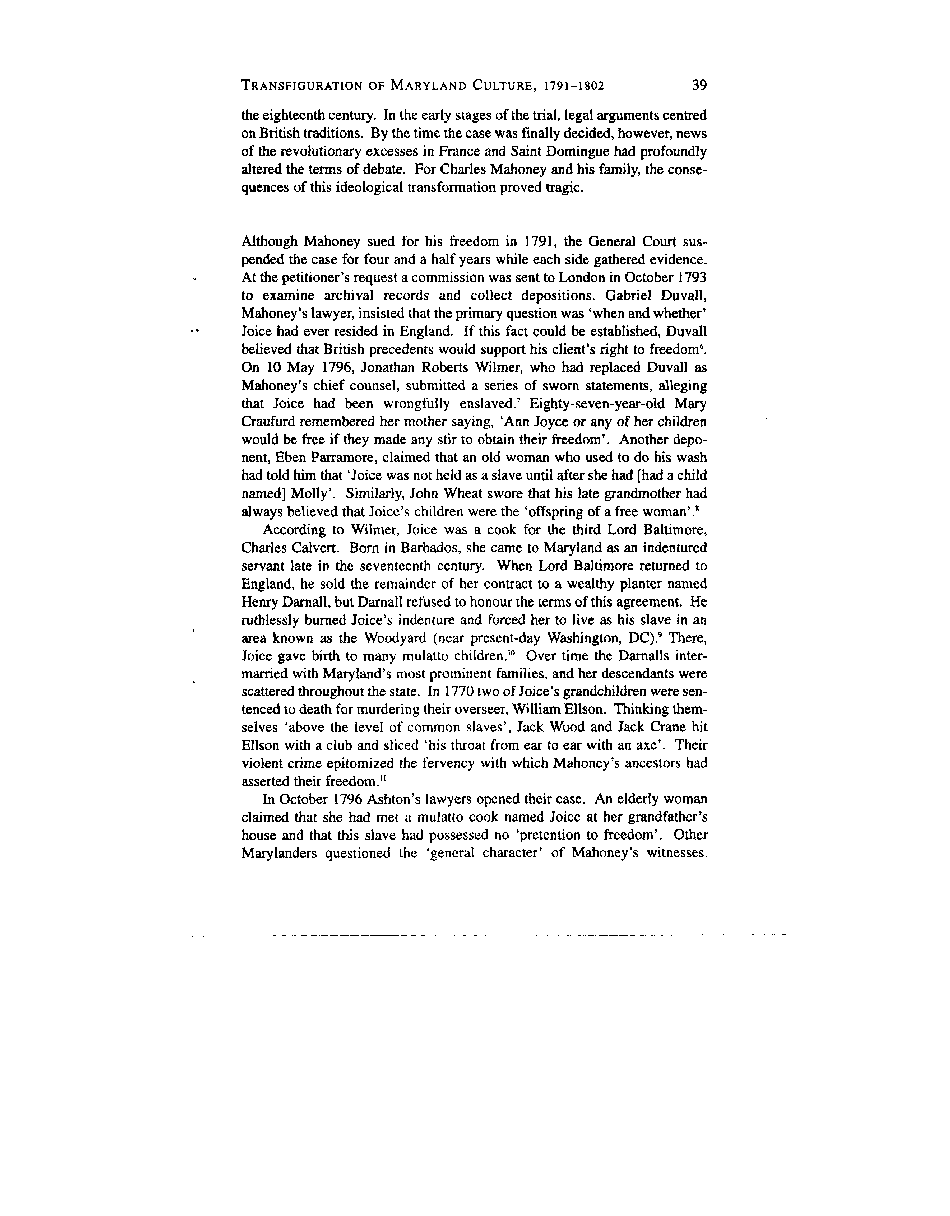|
TRANSFIGURATION OF MARYLAND CULTURE, 1791-1802 39
the eighteenth century. In the early stages of the trial, legal arguments centred
on British traditions. By the time the case was finally decided, however, news
of the revolutionary excesses in France and Saint Domingue had profoundly
altered the terms of debate. For Charles Mahoney and his family, the conse-
quences of this ideological transformation proved tragic.
Although Mahoney sued for his freedom in 1791, the General Court sus-
pended the case for four and a half years while each side gathered evidence.
At the petitioner's request a commission was sent to London in October 1793
to examine archival records and collect depositions. Gabriel Duvall,
Mahoney's lawyer, insisted that the primary question was 'when and whether'
Joice had ever resided in England. If this fact could be established, Duvall
believed that British precedents would support his client's right to freedom6.
On 10 May 1796, Jonathan Roberts Wilmer, who had replaced Duvall as
Mahoney's chief counsel, submitted a series of sworn statements, alleging
that Joice had been wrongfully enslaved.' Eighty-seven-year-old Mary
Craufurd remembered her mother saying, 'Ann Joyce or any of her children
would be free if they made any stir to obtain their freedom'. Another depo-
nent, Eben Parramore, claimed that an old woman who used to do his wash
had told him that 'Joice was not held as a slave until after she had [had a child
named] Molly'. Similarly, John Wheat swore that his late grandmother had
always believed that Joice's children were the 'offspring of a free woman'.8
According to Wilmer, Joice was a cook for the third Lord Baltimore,
Charles Calvert. Born in Barbados, she came to Maryland as an indentured
servant late in the seventeenth century. When Lord Baltimore returned to
England, he sold the remainder of her contract to a wealthy planter named
Henry Darnall, but Darnall refused to honour the terms of this agreement. He
ruthlessly burned Joice's indenture and forced her to live as his slave in an
area known as the Woodyard (near present-day Washington, DC).1* There,
Joice gave birth to many mulatto children.10 Over time the Darnalls inter-
married with Maryland's most prominent families, and her descendants were
scattered throughout the state. In 1770 two of Joice's grandchildren were sen-
tenced to death for murdering their overseer, William Ellson. Thinking them-
selves 'above the level of common slaves', Jack Wood and Jack Crane hit
Ellson with a club and sliced 'his throat from ear to ear with an axe'. Their
violent crime epitomized the fervency with which Mahoney's ancestors had
asserted their freedom."
In October 1796 Ashton's lawyers opened their case. An elderly woman
claimed that she had met a mulatto cook named Joice at her grandfather's
house and that this slave had possessed no 'pretention to freedom'. Other
Marylanders questioned the 'general character' of Mahoney's witnesses.
�
|

